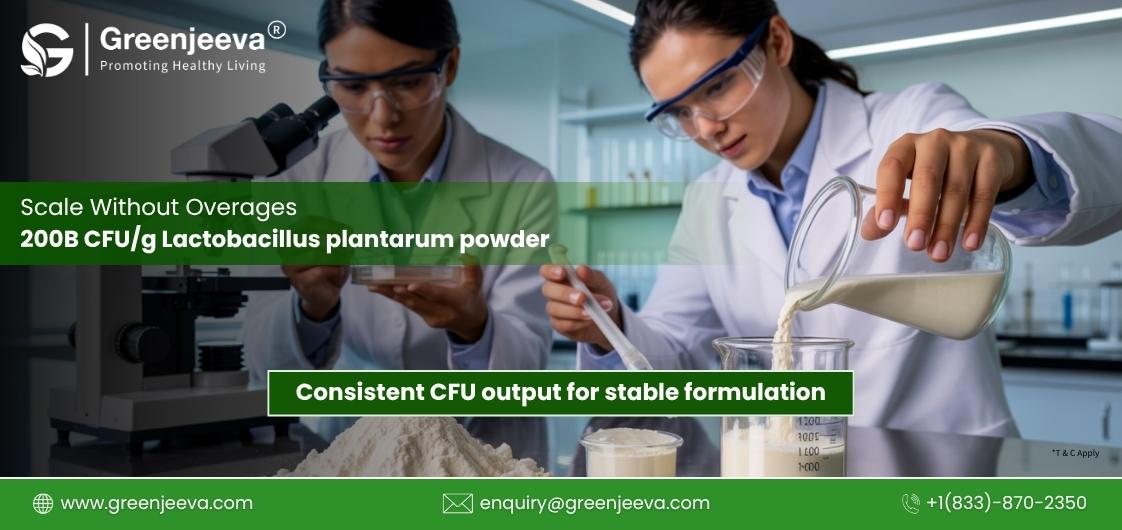Is bulk Lactobacillus plantarum 200B CFU powder cost-efficient for manufacturing?

Formulators and procurement teams across the nutraceutical and functional product industries face the same challenge: how to maintain probiotic potency without increasing formulation cost or operational complexity. As finished product formats shift toward smaller serving sizes, cleaner labels, and minimal excipients, more manufacturers are evaluating Lactobacillus plantarum powder 200B CFU/g as a high-density live culture option.
Instead of purchasing lower-potency powders that require higher inclusion rates, many buyers now question whether bulk Lactobacillus plantarum powder at 200 billion CFU/g can be a more cost-efficient choice—especially when scaling to tens of thousands of units.
This article breaks down cost efficiency, formulation impact, documentation needs, and typical sourcing challenges for lactobacillus plantarum 200B CFU powder in high-volume manufacturing.
Does a 200B CFU/g potency reduce dosage requirements and overall batch cost during scale-up?
Yes. The first driver of cost efficiency is dosage density. At 200B CFU/g, formulators often require less powder per batch to reach the target CFU per serving.
Key cost-related advantages:
- Lower inclusion rate (grams used per blend decrease)
- Smaller capsule size or reduced fill weight (capsule machinery runs faster with lower torque resistance)
- Lower freight and warehousing cost (less powder volume per SKU)
- Better flexibility in multi-strain blends (more room in the matrix for other actives)
Example concept (not claiming health benefit):
- Target potency per serving: 10B CFU
- Using a 200B CFU/g material → only 0.05 g per serving needed
- Using a 50B CFU/g material → 0.20 g per serving needed
Less material affects everything: component yield, capsule count per kg, packaging rounds, and time on mixing equipment.
How does CFU density influence fill weight, stability, and batch yield?
Higher potency directly improves operational efficiency:
- Less powder reduces dusting and carryover in mixers.
- Fill-weight variability decreases, reducing rejects.
- Shorter mixing cycles lower time-on-equipment costs.
- Leaner ingredient mass helps avoid overfill on tablets, sachets, and stick packs.
Because lactobacillus plantarum powder is typically freeze-dried, it behaves like a light, porous biomass. When using a carrier system (maltodextrin or inulin), flowability improves further. For clean-label-focused brands, some suppliers also produce food-grade Lactobacillus plantarum for supplements using inulin as a carrier—procurement teams often prefer this when aiming to reduce label complexity.
What documentation should buyers request before approving a supplier?
Every strain of Lactobacillus plantarum powder 200B CFU/g is not automatically equivalent. Strain identity is essential for regulatory compliance and traceability.
Procurement teams request the following documentation before approving a vendor:
For buyers in the U.S., choosing a GMP certified probiotic supplier USA reduces audit complexity and ensures consistent batch reproducibility.
Which factors influence viability loss during packaging, storage, and global logistics?
Stability of lactobacillus plantarum 200B CFU powder depends on:
- Moisture exposure (water activity <0.2 is commonly required)
- Packaging barrier quality (aluminum foil bags or PET jars)
- Temperature fluctuations during shipping
- Carrier system (inulin or maltodextrin influence survivability)
Procurement teams should confirm:
- Potency guaranteed at the end-of-shelf-life, not only at production
- Nitrogen-flushed packaging or desiccants are used for transit
- Correct temperature labeling (ambient vs refrigerated)
A supplier that only guarantees CFU at the time of manufacture shifts risk onto the buyer. A supplier that guarantees CFU at end-of-shelf-life assumes responsibility for viability loss.
Is a pure concentrate more cost-efficient than a carrier-blended powder?
Cost efficiency depends on the goal:
Manufacturers using capsule or stick-pack automation generally prefer carrier-blended material for smoother handling. Formulators prioritizing clean label formats often request inulin-based carriers.
Which evaluation criteria reduce supply chain risk when buying in bulk?
Procurement teams use a checklist similar to this:
- Confirm supplier is a bulk probiotic ingredient supplier (not a reseller)
- Request batch-level documentation (COA, MSDS, spec sheet)
- Confirm that the strain originates from a GMP certified probiotic supplier USA
- Ensure FDA & GRAS compliant probiotic ingredient documentation applies to the strain
- Ask for sample quantity for pilot formulation
- Evaluate lead times, MOQ, and warehouse location (domestic warehousing reduces transit risk)
- Confirm potency guarantee (manufacturing vs end-of-shelf-life)
Also confirm:
- Excipient identity
- Allergen status
- Water activity control
- Packaging type (foil bag, vacuum-packed, nitrogen flushed)
How does potency contribute to lower capsule manufacturing costs?
High density per gram improves throughput:
- Shorter blending time = lower labor cost
- Lower fill weight = fewer capsules per SKU
- Reduced micro-contamination risk due to shorter exposure time
- Less material loss in transition points during mixing
This matters significantly for facilities doing probiotic contract manufacturing where speed and clean-down time drive margins.
Conclusion
When comparing cost-efficiency between low-potency probiotic powders and Lactobacillus plantarum powder 200B CFU/g, the determining factor isn’t just the price per kilogram. The correct evaluation metric is cost per finished unit and ability to maintain potency through the supply chain.
- In high-volume nutraceutical manufacturing, bulk lactobacillus plantarum powder at 200B CFU/g can reduce formulation mass, packaging runs, and machine load—leading to lower operational costs and better batch yield.
- Buyers who request the right documentation, evaluate strain traceability, and choose food-grade Lactobacillus plantarum for supplements from a GMP certified probiotic supplier USA reduce sourcing risks and maintain batch consistency.
If you are evaluating bulk Lactobacillus plantarum powder 200B CFU/g for large-scale runs and need samples, COA, documentation, or MOQ details, connect with us. Simply register in our website and get pricing and real time stock information, order free samples and download all the compliance documents including COA, spec and MSDS in one click. It’s completely free!
Register Now.
**The Food and Drug Administration has not evaluated these statements. This product is not intended to diagnose, treat, cure, or prevent any disease.**





